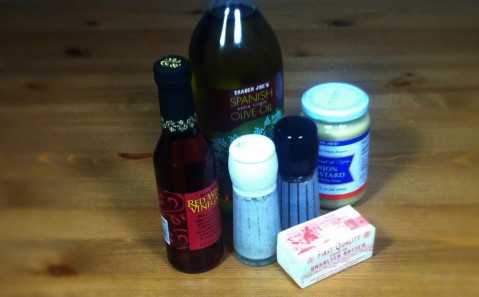
Take a look in your pantry right now. What do you see?
Look beyond the cereal boxes, half-eaten bags of chips, and boxed pasta mixes. What is there that you’d add to your food if you wanted more flavor?
If you were to cook from scratch, what could you use to make your dishes of meat and vegetables tastier?
It’s tempting to just grab pre-made sauces and spice mixtures tailor-made for every dish and world cuisine you can find at the supermarket. But I strongly suggest you don’t.
Before you know it, you’ll end up with a pantry full of half-eaten condiments that are just gathering dust before you finally have to toss it once it expires.
The amount of things you should always stock in your pantry is surprisingly small.
In can be incredibly daunting to start stocking a kitchen when you start learning how to cook, but it doesn’t have to be. Focus on the basics first and build from there as you get more comfortable (and adventurous).
The following six items will ensure that you can take literally any type of food, cook it up with your minimalist kitchen equipment, and turn out a ridiculously delicious dish that you can eat over and over again.
The Essentials
Salt
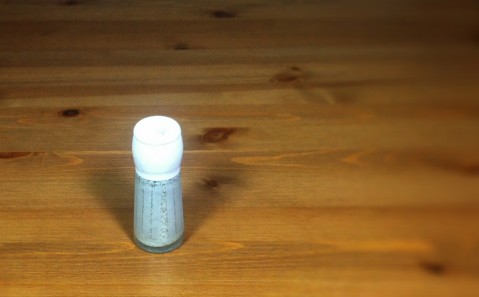
Like fat, salt gets an unnecessarily bad reputation.
It’s one of those ingredients that we are constantly told we must eliminate as much as possible in order to reduce blood pressure (amongst other things).
But salt has been a part of the human diet for a long time, and without it we would die.
We would have originally gotten our salt from the seafood we ate, but over time we realized that salt was fantastic as a food preservation technique. (It’s easy to forget that refrigeration didn’t come into widespread use until the last 100 years.
But the best effect of adding salt to food is the increase in flavor, which is why now no dinner table is complete without a salt shaker.
While getting some sea salt will give you some hardcore “kitchen cred,” you’d be hard-pressed to be able to taste the difference between it and the cheapo store brand.
Also, unlike pepper, salt’s flavor isn’t improved by grinding, which merely is a way to reduce the size of the granules. So unless you want to be able to use the same salt for salting your margarita glasses as you do for adding some flavor to your pork chop dinner, you can probably get away with just the regular fine salt.
Pepper

In the States, we think of “salt and pepper” as a solitary unit–a necessary addition to all dishes.
But while salt (or salt-based sauces) are the basis of most cultures’s cuisines, pepper use is much less widespread.
Where it is used most is in “Western” cuisines, which means that for most of the meals you are going to cook, you’re going to want it.
You can leave out most herbs and spices, but for most readers of this article, a meal just won’t taste right without a little bit of pepper.
A cheap shaker of pre-ground pepper will certainly do the trick here, but if you want to take things to the next level, get yourself a pepper grinder and whole peppercorns.
Unlike salt, pepper’s flavor is greatly enhanced if it is ground just before eating, so you’ll get some bonus points from grinding your own.
(As an intermediate step, you can often find plastic “one-time use” grinders filled with peppercorns at most grocery stores these days.)
Butter
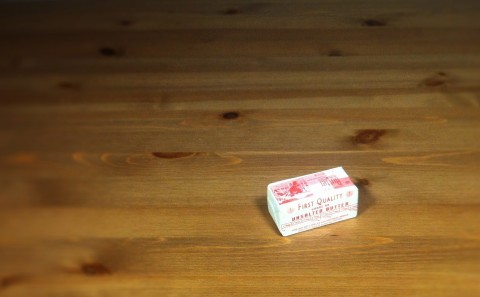
Fat serves a crucial role in the kitchen.
It provides a hot medium to cook food in. It allows it to cook more evenly.
And it tastes really damned good!
Unfortunately, the puritanical movement that believes that everything that is enjoyable must be inherently bad has convinced the world that fat is one of the most unhealthy things you can put in your body.
Except, y’know, people have been eating LOTS of fat for millions of years with none of the problems we now attribute to it.
Fat is useful in the kitchen. It is tasty. And it is (wait for it…) HEALTHY!
(And yes, I know that butter isn’t technically a pantry item, but it’s just as essential as everything else on this list. Just keep it in the fridge, fercryinoutloud.)
You can find butter anywhere you can find food, from high-end organic stores to gas stations, and you should always have some on hand.
I’d suggest getting unsalted butter. Since you always have salt on hand, there’s no reason to get it added in already.
Extra Virgin Olive Oil
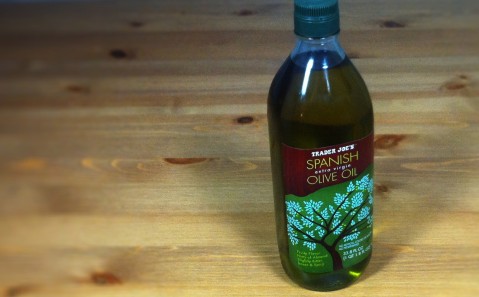
Extra-virgin olive oil (that’s EVOO to you, bub) is another great kitchen staple, though things get a bit tricky here.
You can thank the low-fat fad for the rise of olive oil. It is low in saturated fat, and one of the cornerstones of the “Mediterranean Diet,” and is therefore something that can be easily found these days.
EVOO is one of the few vegetable oils I’d suggest using in large quantities. It undergoes very little processing, and is low in the inflammation-causing omega–6 fats that cause me to urge caution with most plant-derived fats.
You can use olive oil for frying, but I’d suggest you keep it for low heat only to reduce the amount of degradation.
Where olive oil really shines is as a topping you add after cooking to add in more flavor, especially when paired with vinegar (which I’ll get to later).
On a per-calorie basis, EVOO also ends up being quite a bit more expensive than butter, which is another reason to use it more sparingly.
Since olive oil is much more unstable and prone to going rancid than butter, I’d also suggest you do a bit of research and find a good quality brand.
Unfortunately, the EVOO has resulted in a lot of companies using shady methods to increase their profits on this highly-sought after ingredient, and the real stuff is actually quite hard to find.
A good rule of thumb is that good EVOO should solidify if put into the refrigerator for a couple days.
For what it’s worth, I’ve found Trader Joe’s Spanish EVOO to be tasty, cheap, and it passes the “refrigerator test.”
Wine Vinegar
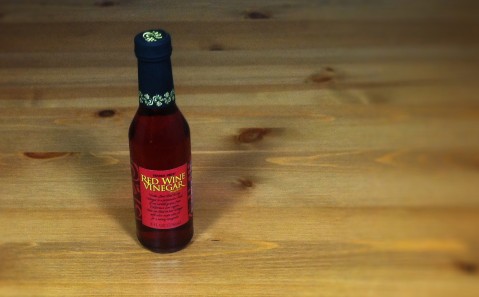
Vinegar is alcohol’s destiny.
Ever since people discovered how to turn sugar into alcohol, they’ve inevitably been left with plenty of the by-product as the alcohol converts into acid.
Fortunately, this acid (or vinegar) happens to be quite tasty and versatile as well, and humans around the world have been using it in their food to add flavor and nutrients.
While rice vinegars are most common in Eastern Asia, the most common vinegar in most Western cuisine comes from wine. Red wine, white wine, sherry, champagne… the list goes on and on.
It’s best to just try different wine vinegars and find which one you like best. (I use a basic red wine vinegar for most everything and find that it works just fine.)
When combined with olive oil, salt, and pepper, vinegar forms one of the most delicious, healthy, and versatile sauces you can use in the kitchen: vinaigrette.
Mustard
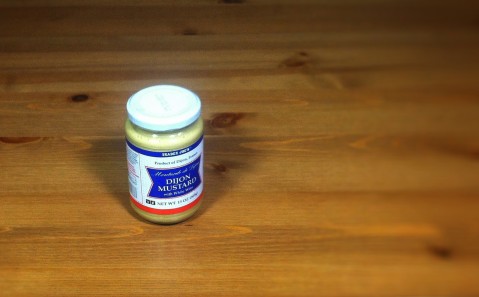
Most people don’t think of mustard as being a pantry essential, but you’d be surprised how useful it can be in even the most minimalist of kitchens.
Add a little bit to your vinaigrette. Add some to the butter you’re frying with for added flavor (just like In-N-Out does with their animal-style burgers!), or just spread some on your meat before eating.
Do yourself (and everyone eating with you) a favor and get a decent dijon-style mustard.
The neon yellow stuff has its place, namely on hot dogs, but is much less versatile than the more fully-flavored dijon mustards.
Doing More With Less
I should mention at this point that this list is focused primarily on those of you who live in “Westernized” countries (The Americas, Europe, Australia, etc.)
Since I’m writing in English, you are probably the key market for this, but I should mention as well that this might be different if you live in Asia, the Middle East, or Africa.
As you become more interested in world cuisine, you can branch out to add some more spices, herbs, and ingredients into the mix, but these six things can still cover most of your needs in the beginning.
For most people in Western cultures, little more than a combination of salt, pepper, butter, olive oil, vinegar, and mustard is necessary to create a delicious meal.
Salt and pepper are crucial flavors. Olive oil and butter add fatty healthy goodness. And vinegar and mustard give everything a little kick.
Make sure you keep these essentials stocked in your kitchen at all time and you’ll be able to take literally any combination of meat and vegetables and turn them into a tasty meal.
As you get more comfortable and experimental in the kitchen, then you can branch out. But make sure you master the basics first.
What are your favorite pantry items you always keep on hand?
 I'm a science geek, food lover, and wannabe surfer.
I'm a science geek, food lover, and wannabe surfer.
Comments on this entry are closed.